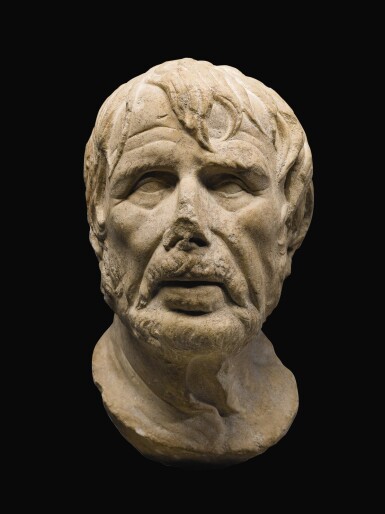
Property from a Delaware Private Collection
A ROMAN MARBLE HEAD OF A GREEK POET, PROBABLY HESIOD, CIRCA 1ST CENTURY A.D.
Auction Closed
December 3, 05:06 PM GMT
Estimate
1,000,000 - 1,500,000 GBP
Lot Details
Description
Property from a Delaware Private Collection
A ROMAN MARBLE HEAD OF A GREEK POET, PROBABLY HESIOD, CIRCA 1ST CENTURY A.D.
or Euripides, turned to his left and gazing up with an energized and intensely concentrated expression, with unkempt beard and unruly hair radiating from the crown and falling in long locks over the forehead, temples, and nape of the neck; no restorations.
Height 33 cm.
Nils Ebbessøn Astrup (1901-1972), Oslo, acquired in Rome in the 1950s on the advice of Prof. Hans Peter L'Orange (1903-1983), founder and then Director of the Norwegian Institute in Rome
private collection, United Kingdom, by descent (Sotheby’s, New York, June 8th, 2011, no. 42, illus.)
Recorded
Deutsches Archäologisches Institut, Rome, neg. nos. 54.995-998 (http://arachne.uni-koeln.de/item/objekt/23905)
Published
Oscar Thue, "Utstillinger i Oslo varen 1959," Kunst og Kultur, vol. 42, 1959, p. 257, illus.
Axel Seeberg, "Two Pseudo-Seneca Replicas in Oslo," Symbolae Osloenses, vol. 35, 1959, pp. 98ff., figs. 3-5
Axel Seeberg, "Disjecta membra," Acta ad archaeologiam et artium historiam pertinentia, vol. 1, 1962, p. 17f., pl. 3b-c
Gisela M. A. Richter, The Portraits of the Greeks, vol. 1, London, 1965, p. 61, no. 38, figs. 207-9
Siri Sande, "Antikke portretter i norsk privateie," Kunst og Kultur, vol. 56, 1973, p. 42f., illus.
Siri Sande, "Greek and Roman Portraits in Norwegian Collections," Acta ad archaeologiam et artium historiam pertinentia, vol. 10, 1991, p. 16f., no. 8, pl. 8
This impressive and expressive head belongs to a Hellenistic portrait type known in at least fourty replicas. The identification is still uncertain. Identified as Seneca in the 16th Century, it was given a plethora of names by modern scholarship, e.g. Hesiod or Aesop (for an overview of the suggested identifications see Richter, op. cit., pp. 63ff.). Lastly, W. Fuchs, Thetis, vol. 11/12, 2005, pp. 113ff., argued for an interpretation as a Hellenistic re-imagination of the portrait of Euripides (cf. E. Voutiras, Archeologia Classica, vol. 60, 2009, p. 95).
Seeberg, op. cit. 1959, p. 109 remarks: "This was a man of long ago – a semi-legendary figure of the remote past, maybe, at any rate not likely to have flourished later than the early years of the Hellenistic age. The artist visualised him as a bitter, aged fellow, clearly with some sort of an axe to grind, probably not kindly treated by Fate or by his contemporaries. He was a man of the spirit – poet, or thinker, or both – and of immense fame, whether universal or confined to a large circle of ardent devotees."
